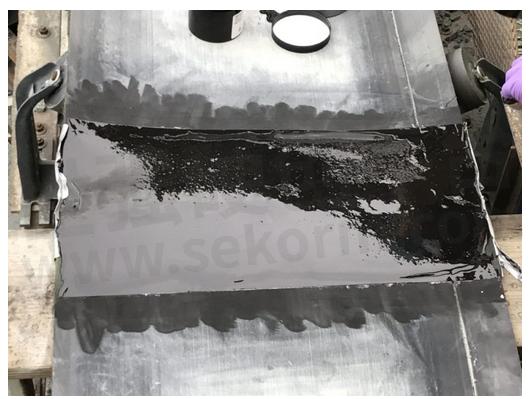Rubber Repair with Polyurethane Coatings


Introduction
There are many types of rubber materials made from natural and synthetic materials. A very common one we all see is Neoprene. Rubber is a versatile material that gets used, damaged, and repaired in a wide range of applications from pipe leak repair in automotive to water leak repair in industrial construction. Like any material, rubber can suffer from both unexpected failures to common wear, environmental exposure, and age, that may include tears, cracks, and leaks. Fortunately, polyurethane that can have very similar properties to rubber, is an excellent material for repairing rubber materials and could even be used in sealing leaks and acting as rubber patching.
Polyurethane is considered a synthetic polymer rubber that can be formulated to have a range of properties, including elasticity, flexibility, and durability. This makes it an ideal material for repairing the many types of rubber, as it can be tailored to meet specific needs like performing a seam seal. Whether polyurethane is being used for poured rubber flooring or even as a solution for pipes with rubber lining, polyurethanes offer both durability and flexibility. When you need elastomeric materials to repair or rebuild rubber, consider polyurethane coatings.
Rubber Repair with Polyurethanes
There are several methods for repairing rubber with polyurethane, depending on the type and severity of the damage. Here are some common methods:
1. Injection Molding or Pouring: This method involves injecting polyurethane into the damaged area of the rubber, which then cures and hardens to form a strong, flexible seal. This method is best suited for larger tears or cracks.
2. Spray Coating: This method involves spraying a layer of polyurethane onto the surface of the rubber, creating a protective coating that can prevent further damage. This method is best suited for smaller cracks or leaks.
3. Dip Coating: This method involves dipping the damaged area of the rubber into a bath of polyurethane, creating a protective coating that can prevent further damage. This method is best suited for small, localized areas of damage.
Benefits of Rubber Repair
Regardless of the repair method used, repairing rubber with polyurethane offers several advantages. Polyurethane is highly resistant to abrasion, chemicals, and weathering, making it ideal for use in harsh environments. It also has excellent adhesion to rubber, ensuring a strong, long-lasting repair.
In addition, polyurethane is highly customizable, allowing for the creation of materials with specific properties, such as increased elasticity or improved flexibility. This makes it possible to create repairs tailored to the specific needs of the application.
Overall, repairing rubber with polyurethane can be an effective and reliable solution for addressing common problems associated with rubber materials. Whether through injection molding, directly pouring, spray coating, or dip coating, polyurethane can help extend the life of rubber materials and keep them functioning at their best.
- +1 Like
- Add to Favorites
Recommend
- Functional Characteristics of Polyurethane Adhesive
- WACKER Presents Innovative Solutions in Construction and Coatings at PAINTINDIA
- Abrasion Resistance with Epoxies and Polyurethanes
- Devcon® Coatings Protect Assets from Harsh Chemical Environments
- Devcon® Coatings Protect Surfaces from Impact and Reduce Equipment Downtime
- Huitian 8960S PU Adhesive , Polyurethane Sealant Successfully Implemented at Avtovaz !
- Hansi Introduces Solvent-free, Two-Component Polyurethane Adhesive YEBOND®05GP for Bonding Honeycomb and Corrugated Panels
- Polyurethane Adhesive Construction Technology
This document is provided by Sekorm Platform for VIP exclusive service. The copyright is owned by Sekorm. Without authorization, any medias, websites or individual are not allowed to reprint. When authorizing the reprint, the link of www.sekorm.com must be indicated.





























































































































































































































































































































































































































































































































































































































































































































































































































































































